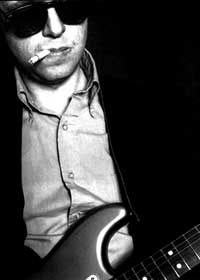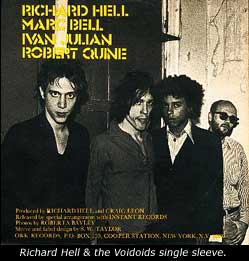To those in the know, Robert Quine is one of the most original and influential guitarists of the past 25 years. A founding member of the groundbreaking punk rock ensemble, Richard Hell & the Voidoids, Quine has gone on to collaborate with a diverse array of musicians during his career, including: Lou Reed, Brian Eno, John Zorn, Matthew Sweet, Tom Waits, Lloyd Cole, They Might Be Giants, and Marianne Faithfull.
Quine's guitar speaks with a distinctive and versatile voice that immediately identifies him. Shrieks of feedback, throbbing drones, fractured chords, and keening lead lines are all part of Quine's sonic vocabulary - one that often leaves the listener feeling assaulted, yet enlightened.
Despite the sheer intensity of Quine's playing, it always strives to serve the music first and foremost. "I try to be spontaneous and creative, and generally pull it off," he says. "I've had a lot of influences but somehow have managed to come up with my own touch, my own style."
Born December 30, 1942 in Akron, Ohio, Quine took an early interest in music. He began listening to Brazilian folk music and Gene Autry records as a young boy, and his parents encouraged his interest by presenting him with a Django Reinhardt album. He studied piano briefly in the early '50s, but was transformed by the sounds of rock and roll when it hit in 1955.
Quine began guitar lessons in 1958, but was frustrated early on: "To find someone to teach you to play rock and roll then was rough. I had to figure it out on my own. A friend showed me an E chord and I figured it out from there." He got his first Fender Stratocaster - for years his signature instrument - after seeing his idol Ritchie Valens holding one on the cover of his first album.
As a college student in Indiana in 1961, Quine discovered the blues, after watching rock and roll devolve into a teeny-bopper phenomenon. He hosted a radio program on campus, playing the music of John Lee Hooker and Lightning Hopkins. The blues would make way for jazz, as he developed an interest in artists such as Kenny Burrell, Lester Young, and John Coltrane.
It was in college where he also started his first band, playing mostly covers by the likes of Link Wray, The Ventures, and Duane Eddy. By 1965 he was attending law school in St. Louis, and performing in a band inspired by early Rolling Stones and Byrds albums. At this time Quine discovered The Velvet Underground - a band whose influence would prove considerable to his development as a musician.
After passing the Missouri bar in 1969, Quine relocated to San Francisco. In a city populated by fans of the Grateful Dead and Jefferson Airplane, Quine continued to gravitate toward the strains of The Velvet Underground. He attended numerous Velvets shows at the Matrix, recording hours of their performances on cassette tape.
New York City was the next stop for Quine, arriving in August 1971. On the strength of his law credentials, Quine settled into a three-year stint writing tax law for Prentice Hall Publishing. "There's nothing more boring," he says, explaining his decision to drop law and make music his livelihood.
In 1975 Quine got a job at a film memorabilia shop, where co-workers included Tom Verlaine and Richard Hell. Quine eventually put a band together with Hell, recruiting Marc Bell (who would later join The Ramones) and guitarist Ivan Julian. In 1977, this quartet Richard Hell & the Voidoids released Blank Generation, a landmark album of the punk music era.
Twenty-three years and numerous session assignments later, Robert Quine's place in modern music - as a driving collaborative force and guitar innovator - is assured.
![]()

